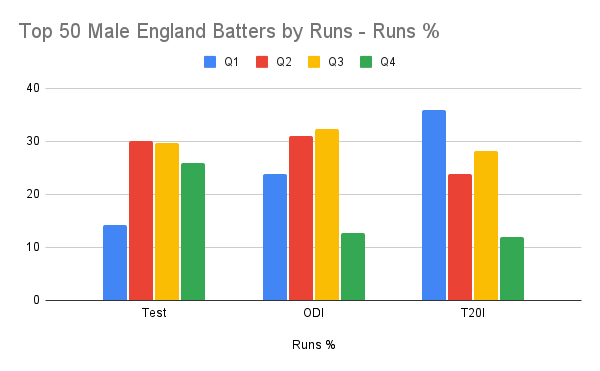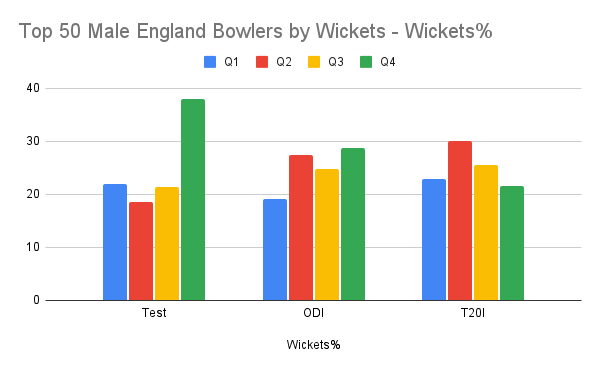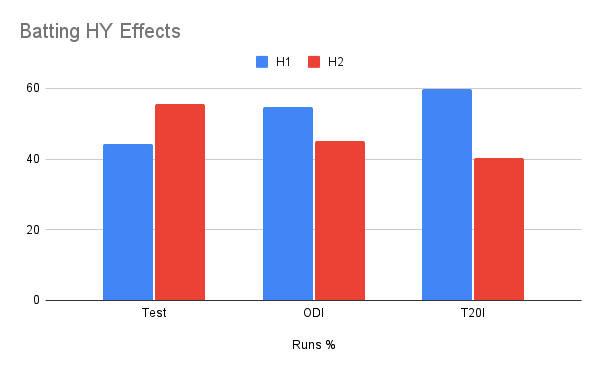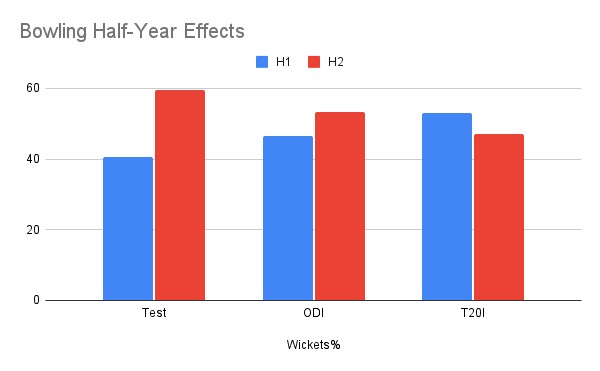How Goldilocks beats David & Goliath. A look at the Underdog Effect in English Cricket
In international cricket, male English later borns DO NOT do better than early borns.
In general middle born (Q2 & Q3) do better with the following exceptions:
Q4 best for Test bowling
Q1 best for T20 batting
Q4 equal to Q2/Q3 for ODI bowling
Q4 equal to Q2/Q3 for Test batting
What data has been used?
An analysis of the Birth Quarters (BQ) of the Top 50 batters by runs and bowlers by wickets for each of the formats (Test, ODI & T20I) was undertaken.
This data is derived from all male England players (Test n=699, ODI n=263, T20I n=91).
Results


Half-Year Effects
What do we see when we combine the BQs into a comparison between early born, H1 (Q1&Q2) with later born, H2 (Q3 & Q4).


H2 perform better in only 3 of the 6 format/role combinations. H2 are better at Test batting & bowling and ODI bowling. H1 are better at ODI batting and T20I batting & bowling. These effects are mostly due to variable effects from Q1 and Q4. Q2 & Q3 are far more similar to each other and consistent across the study.
There is a noticeable linear relationship between Half Year and Format. H1 perform better the shorter the format and H2 perform better the longer the format.
Limitations
This only applies to English cricket. Differences in Relative Age Effect profiles have been found across the world and further investigation is required to see if normal RAE exists, or if a Goldilocks or Underdog Effect is dominant.
T20I bowlers were only n=44. The first match of this format for the England men’s team was only in 2005 and only 91 players have ever played.
Analysis for ODI & T20I effectiveness could be carried out by Strike Rates for batters and Economy rates for bowlers but for a comparison between all three formats, then runs and wickets were chosen.
Conclusions
Contrary to popular belief Q4s are under-represented in English national cricket teams for ODI batting & T20 batting and bowling. Q4s are equally represented in Test match batting and ODI bowling to Q2 & Q3 and only excel in Test match bowling.
Two linear relationships appear. Q4s appear to be best at Test cricket and worst at T20I for both batting and bowling. In contrast, Q1s appear to be best at T20I and worst at Test batting.
Q2 & Q3 are the most consistent BQs and are very similar in all formats and role. For batting they are the best for Tests & ODI. For bowling they are consistent performers while there seems to be a linear relationship whereby Q2 & Q3 are more appropriate for shorter formats.
The Underdog Effect suggests later born reach the very highest levels more often in sport due to the higher level of challenge they have endured along the way. It is difficult to argue that there is a Q4 Underdog Effect in male English batting and bowling in ODI & T20Is. Only in Test bowling do Q4s dominate at this level.
An Overdog Effect is the opposite of an Underdog Effect, whereby early born have not been challenged enough during their development and then do not possess the required skills to reach the very highest levels. For batting it could be argued that there is an Overdog Effect for Q1s. They significantly under-perform at Test level, are second to Q2/Q3s in ODIs and only excel in T20I. H2 bias is found equally to H1 bias across the 6 format and role (batting/bowling) combinations.
Using David v Goliath as an analogy, David is represented by the less developed/under represented Q4s in development pathways. Goliath is represented by the more developed and over represented Q1s. The Q4 Davids have had to struggle in the system and consequently may have had fewer opportunities. The Q1 Goliaths have been over-represented in the system and having had many opportunities have not developed enough through being constantly under challenged.
But perhaps the real winners, in most instances, are the Q2 & Q3 players. They have had a ‘just right’ development journey with a balance between challenge and opportunity, a Goldilocks Effect.